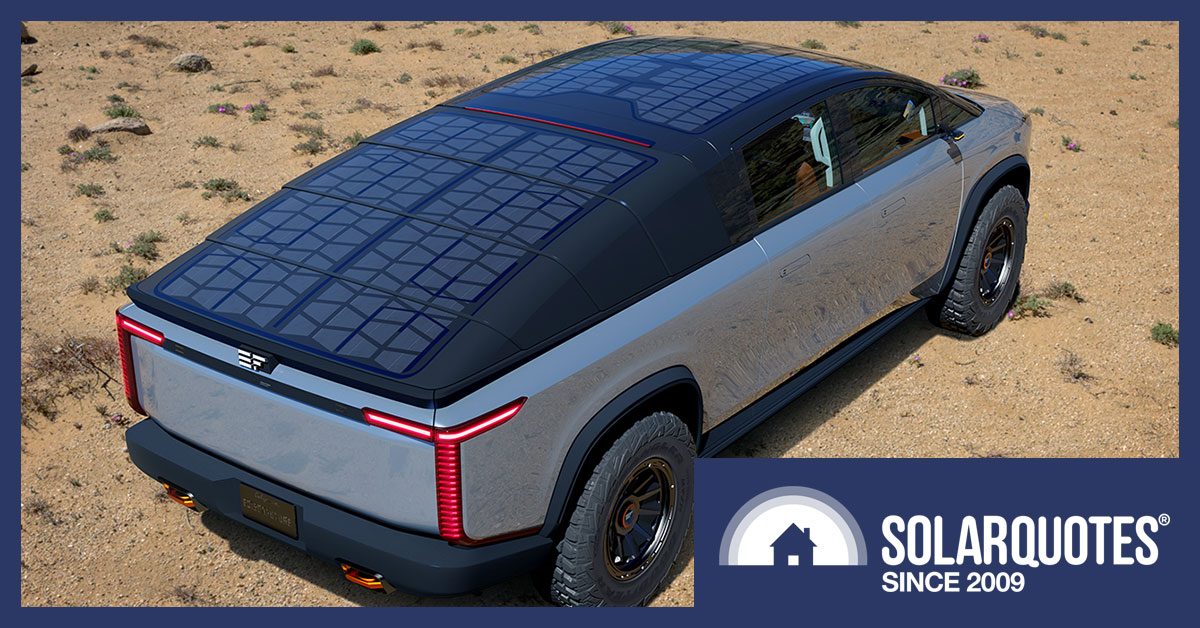
Image: Edison Future
It makes sense to install solar panels on homes, but does it make sense to put solar on cars?
At the time of writing, major electric car manufacturers, such as Tesla and Nissan, don’t offer solar PV on their vehicles.
This looks like a wasted opportunity. In Australia, solar panels integrated into cars at the factory would easily pay for itself. At least for anyone who regularly parks in the sun.
But there are sound engineering and economic reasons why solar cells aren’t a standard inclusion on electric cars yet.
There’s also a secret, dirty reason why EV manufacturers don’t want solar cells on their cars.
While car-integrated solar is very rare right now, the situation is changing. Many new entrants in the EV market offer solar PV either as an option or even a standard feature.
In this article, I’ll explain how integrated solar can — in Australia at least — provide a respectable amount of energy. I’ll also point out how, for a significant number of people, integrated solar panels will provide minimal benefit. I’ll also reveal the dirty secret explaining why manufacturers don’t want solar panels on their EVs, but you’ll have to read to the end to find out. Sure, you could skip ahead to the subheading that says “Dirty Secret Reason”, but I don’t recommend it because I’m not sure you’re prepared to know the full truth just yet.
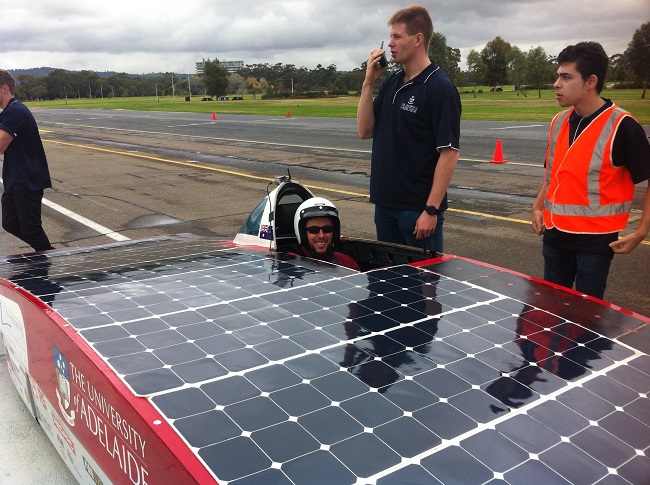
No Finn, this isn’t the sort of EV PV I’m talking about. I’m referring to putting solar on ordinary electric cars for everyday use by people who aren’t nutters like us.
PV On EV Pros & Cons
PV stands for photovoltaics. So when you put solar cells on an electric vehicle, you get EV PV.
EV PV should give plenty of advantages:
- Extending range by supplying energy during the day.
- Reducing power draw on hot sunny days from the air-conditioner.
- Allow the battery pack to slowly charge without a grid connection.
- Protect the battery from harm by preventing its charge level from dropping too low if not used for an extended time.
- Provide emergency power during a blackout. (Even if USB ports are the only power outlets, being able to charge your phone is better than nothing.)
- Reduce charging costs because sunlight is free.
Unfortunately, there are also some drawbacks to EV PV. These include:
- Increased cost.
- Potentially increased battery deterioration due to extra heat from parking in the sun.
- Extra air conditioner energy consumption.
How Much PV Can Fit On An EV?
There’s a limit to how many solar cells you can put on a car. The roof of a sedan or a medium to small hatchback fits around two square meters:
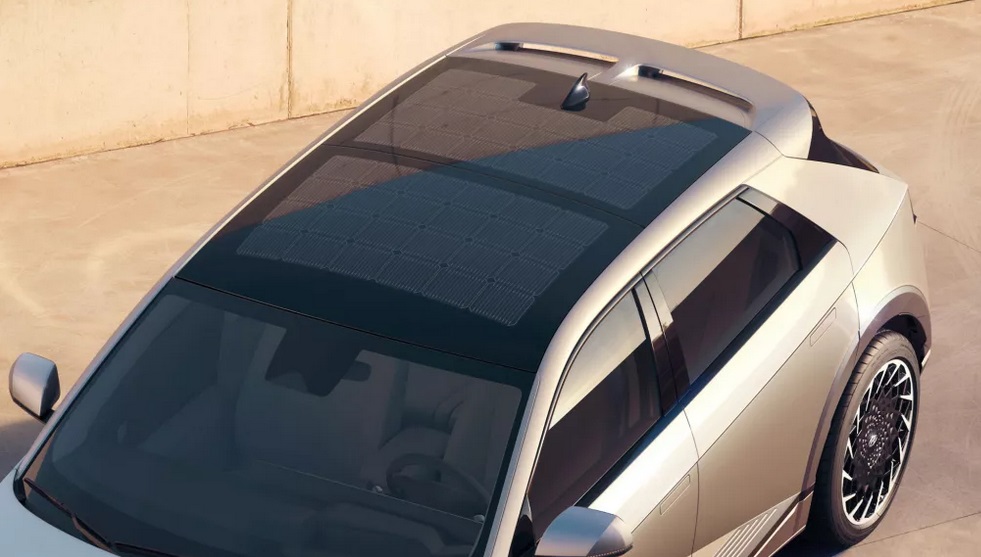
This solar roof is available as an option on the Hyundai Ioniq 5. But you can’t get it in the US, so it’s unlikely to be available for the small number arriving in Australia this year. Based on what Hyundai has said, it will provide around 1 kilowatt-hour a day in sunny locations.
But you can fit a lot more than that. If you are willing to work at it — as the Dutch have with their Lightyear One EV, which launches this year. They’ve been able to fit 5 square meters of PV using the roof and bonnet:
EV PV Energy Output
After accounting for wiring losses, the best commercially available solar cells will have around 22% efficiency when used for EV solar. This will allow each square metre to have 220 watts of solar cells and let the capacity total:
- 2 square metre solar roof: 440 watts
- 5 square metre Lightyear style EV: 1,100 watts
Because these cells are laid flat, they won’t produce as much energy as a typical house roof. Also, the transparent surface that protects them, whether glass or other material, may not transmit as much light as the glass sheet of a typical solar panel. Their output will also be slightly lower if they get hotter because air can’t circulate under them.
With these drawbacks, in Sydney, when parked all day in an area completely free of shade they would generate an average of:
- 440 watts: 1.5 kilowatt-hours daily average in Sydney.
- 1,100 watts: 3.7 kilowatt-hours daily average in Sydney.
Further north in Brisbane, the results are a little better:
- 440 watts: 1.7 kilowatt-hours daily average in Brisbane.
- 1,100 watts: 4.2 kilowatt-hours daily average in Brisbane.
There will be losses from charging the battery. This can potentially be under 1% but will depend on how much effort the manufacturer puts into keeping the loss low.

This is tangential to EV PV, but if you want to be around to enjoy our clean energy future, I recommend getting vaccinated against COVID. I’ve had my booster shot, so I’m confident I’ll be around at least a while longer.
How Much Range Per Day From Solar Power?
The energy efficiency of EVs varies, but they typically get 5 to 9 km per kilowatt-hour of battery charge. Ignoring the — hopefully — trivial losses from battery charging, each kilowatt-hour of solar energy should extend the range of a typical EV by around 7 km. Using the 1.5 kilowatt-hour daily average in Sydney from a 440 watt solar roof, it could take you 10.5 km, assuming no significant shading. That’s 30% of the average daily distance travelled by Australian passenger cars in the 2018/19 financial year.
With 5 square metres of solar cells, the average daily output in Sydney would provide 25.9 km of range. That’s 75% of the average daily distance travelled.
While it’s not yet available, the Dutch Lightyear One is estimated to get nearly 10 km per kilowatt-hour in real-world driving. This means, if you had one in Longreach, you might never need to plug it in. Even in the middle of winter, the solar electricity output may be enough to drive the average number of kilometres per day. Mind you, not many people in Longreach drive the national average. Even fewer are likely to be able to spare the $310,000 it’s likely to cost1.
In Practice PV Will Usually Add Much Less Range
The figures I’ve given for solar energy generation only apply if the car spends the whole day in the sun. This may already apply to some cars, but they’ll be few and far between. Even if people make an effort to park their electric car in the sun, most will still lose at least some generation to shade. Given the position of my driveway, without a major change in my parking habits, a car with solar would produce perhaps 60% of its potential output. Of course, if my car could drive itself, it could find a sunny spot on its own, like a cat in winter.
For electric cars that spend most of their time in undercover parking, solar generation may only come to a few percent of what an unshaded car would generate. In these cases, EV PV would be an additional expense for little day-to-day benefit, but it would still be useful in an emergency.
What About Weight?
One drawback of putting solar PVs on EVs is it will add weight and so reduce range. Fortunately, the added weight is almost trivial. Even for cars always parked under cover, PV will add to the car’s range unless it’s mostly only driven at night.
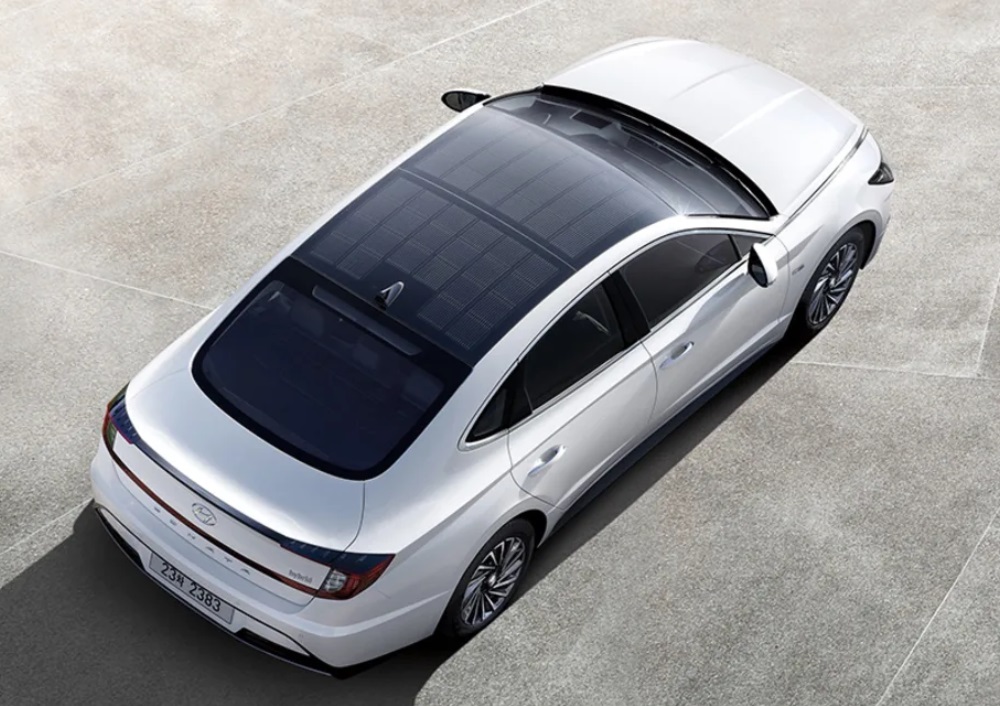
This isn’t an EV but the most expensive version of the 2020 Hyundai Sonata hybrid. It has a glass roof, and the solar cells are on the underside of it. (Image: CarsGuide)
The datasheet for a high efficiency 400 watt solar panel says it weighs 19 kg. That’s 47.5 grams per watt. But the glass cover and aluminium frame won’t be required if solar cells go on the underside of a glass roof, as with the Hyundai vehicle shown above. This will allow PV to weigh much less per watt for this kind of roof.
If a car has a metal roof, putting solar cells on the underside won’t have a good outcome. But there are lightweight solar panels currently available, without glass, that are 430 watts and only weigh 7.2 kg. That’s 16.7 grams per watt while still as tough as most conventional panels.
Electric car manufacturers are very focused on weight, so I’m certain they’ll have no trouble getting EV PV below 10 grams per watt. It may end up ridiculously light, as Monash University has already developed solar cells close to 10 watts per gram and some claim they are getting PV for satellites getting close to 30 watts per gram2. But even using the 16.7 grams per watt figure, 400 watts of PV will only come to 6.7 kg. That’s 0.4% the weight of a Nissan Leaf or Tesla Model 3 SR+. Assuming energy required to move the car increases linearly with weight, it will reduce range by 0.4%. But because the PV won’t affect air or rolling resistance, the reduction is more likely to be around 0.3%.
Around town, cars only average roughly 40 km per hour — depending on where you are and how insane you drive. For an EV that consumes 135 watt-hours per km, the additional 6.7 kg of weight from PV will increase its power consumption from town driving by an average of around 17 watts. Under sunny conditions, a 400 watt panel can provide over 20 times that amount. This means, even on a heavily overcast day, solar PV will add more range when the electric car is motion than it loses due to the additional weight. This will usually be true even for highway driving, where the average power draw can be several times higher. Only an EV mostly used at night wouldn’t gain more range from PV when it is being driven than it loses due to the extra weight.
In addition to almost always increasing range while an EV is being driven with the sun above the horizon, PV will also add range by charging the battery whenever the car is parked outdoors during the day. If a car in Sydney generates half the maximum energy possible from EV PV, it will generate enough energy to provide around 48 times as much range as it loses due to the extra weight. If the PV was 10 grams per watt instead of 16.7 grams, it would be around 80 times more.
EV PV Can Lead To Hotter Batteries
By providing power when the car is driven during the day, EV PV will slightly reduce the average amount of power and energy the vehicle’s battery has to supply. This should have a small but significant effect of extending battery life and slowing its capacity loss.
Working against this is cars parked in the sun get hotter than those in the shade. This can contribute to the very slow degradation that occurs to lithium batteries over time, whether they’re used or not. This capacity loss is extremely slow and will hopefully be easily more than offset by the benefits PV provides the battery. Still, the effects will depend on the type of battery cells, and this could be one reason why EV makers have so far shied away from adding PV to EVs.
Extra Air-Con Energy Loss
Parking in the sun can also result in more energy spent on air conditioning to cool down the cabin.
EVs tend to have much more efficient air conditioner units than conventional cars. A Tesla Model 3 air conditioner at full output only draws around 2.4 kilowatts while providing plenty of cool air. If the air conditioner is run at full power for an extra 3 minutes due to a car being parked in the sun, that will consume 0.12 kilowatt-hours. On a sunny day, 440 watts of PV EV will typically generate that much energy in around 50 minutes, so extra air conditioner use can wipe out a considerable portion of the benefit of parking in the sun.
This extra air-con energy use can be decreased by using a smaller amount of solar-generated energy to blow hot air out of the car interior when its temperature rises too high.
Extra energy use for both ventilation and energy use will only occur on hot days, but there are plenty of them in Australia, and they seem to be getting worse. I could swear it’s as though the country’s average temperature is slowly rising year after year. Provided an EV blows out hot air, extra air-con energy use is likely to be reasonably low, especially if your electric car is smart enough to know when you’re likely to use it and blows hard just before you get in. In winter, parking in the sun can reduce the energy required for heating.
Dirt Will Hurt
Some people keep their cars spotless while others allow dirt to build up layer after layer like the world is their oyster, and they’re hoping their car will turn into a road pearl. If you are one of the former, you won’t have much of a problem, but if you never wash your electric car, its solar cells will be in for a world of dirt.
Rain is usually enough to keep solar panels clean on roofs, but cars are closer to the ground, and roads are dirtier than skies. The amount of grime deposited on cars will decrease as EVs become more popular. This is because a lot of it comes from the exhausts of conventional cars. But even when driving is 100% electric, there will be dust, mud, and insects, (which would actually be a good name for an Australian band). The average electric car owner can expect to lose a couple of percent of solar output to dirt, while some may lose a little more.
The Cost Of EV PV
If you have a factory set up to put solar cells on tens of thousands of vehicles annually, the cost per unit will be relatively low. Getting to that point can cost a hell of a lot of money, but once it’s produced on a large scale, the cost per watt of adding PV to vehicles could fall below the cost per watt of residential solar panels.
At the moment, you can buy good quality solar panels at the factory gate for around 50 cents a watt, but solar cells cost roughly half as much. As some cars already have glass roofs, it should be relatively cheap to place solar cells on the underside, while most vehicles’ metal roofs can still provide support for PV. In standard solar panels, the glass cover and aluminium frame are a significant portion of their price, so the cost per watt of adding PV to an EV should eventually fall below that of solar panels.
If it cost 50 cents per watt to add solar cells to an electric car, then 440 watts of car roof solar would only add $220 to an EV’s cost. With the following assumptions:
- An average generation of 1 kilowatt-hour a day is two-thirds what it would produce if completely unshaded in Sydney.
- An electricity price of 20 cents per kilowatt-hour.
It would only take three years to pay for itself. I should probably add 10% GST to the cost of the PV, but it would still come to a payback period of under three and a half years.
But if your car spends most of its time undercover and only generates one-tenth as much as if it was unshaded, it would take 18 years to pay for itself or 20 years with GST. Most people won’t be happy with a payback longer than the average life of a vehicle, so a solar roof won’t be considered financially worthwhile by many drivers.
For the next couple of years, I expect people will have to pay a lot more than 50 cents a watt if they want to get a solar roof as an option on their EV. For one thing, manufacturers will want to recoup the high initial cost of the production capacity. But competition will drive prices down. I just don’t know when it will happen. If I did know when these sorts of things would occur, I’d be really rich right now.
PV Vs. Battery Tradeoff
The average cost of electric car battery packs is around $186 per kilowatt-hour. Until recently, most EV manufacturers decided to invest in larger battery packs than solar roofs. A major reason is that they have many more customers in Oslo than in Australia. In December in Norway, EV PV will produce next to nothing. Even if you bribed Jack Frost not to snow on the car, it would only generate around 1.3 kilowatt-hours for the whole month if completely unshaded. At the same time, the requirement to heat the battery and the car’s cabin will significantly reduce its range. While plenty of people in northern Europe are interested in having PV on their cars, so far EV manufacturers have decided — probably quite correctly — that most of their customers would be better off if they focused on providing bigger and better batteries rather than PV.
A Dirty Secret Reason Against EV PV
I promised to tell you the dirty secret reason EV manufacturers do not want to put solar on electric cars, so here it is…
Nearly all EV manufacturers don’t offer PV as an option because they want them to stay pretty.
Every EV out in public is an advertisement for its manufacturer. They want them to look good, so people will say, “Mmm… I want one of them!”
Parking in the sun can fade the paint, trim, and upholstery. The last thing electric car manufacturers want to do is give people an incentive to park them in the sun by adding PV. They’d rather you go without its benefits so they can make extra sales.
But this situation is changing. People want solar panels on their cars, the cost has come down, and increasing numbers of new market entrants are saying they’ll either provide it as an option or make it standard on every vehicle. Current large EV makers won’t want to lose sales, so they’ll also offer it. They may try to keep most of their cars looking good by making PV an expensive option, but if demand for vehicle solar power is nearly as strong as I expect it to be, competition will drive down the cost.
Putting PVs on EVs mean more people will complain about sun damage to their vehicles, but it should also slightly extend the life of battery packs. This will benefit manufacturers, as they’ll have to replace fewer under warranty.
EV PV — Coming Soon-ish!
The dam appears to be bursting when it comes to solar on electric vehicles overseas, with many new manufacturers claiming their cars will be able to have it. This is excellent news for Australia, where our high levels of sunshine and plentiful outdoor parking areas will let us put it to good use.
Unfortunately, it will take time for many of these new models to make their way to Australia, but I assume in a year, getting an EV with a solar roof will no longer be a near impossibility.

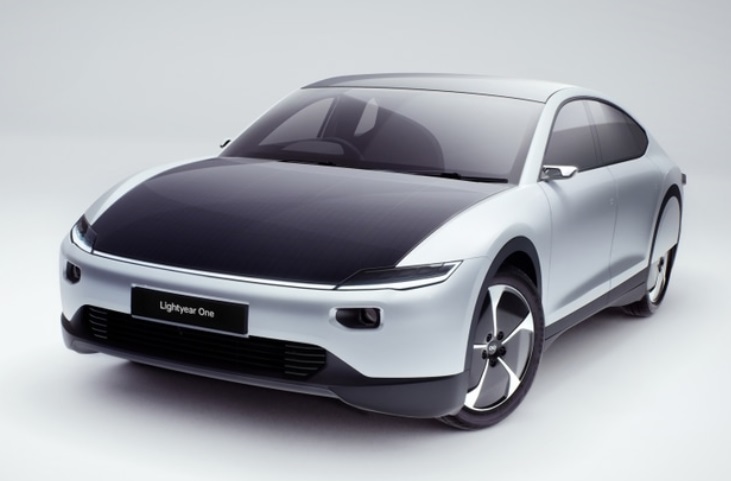
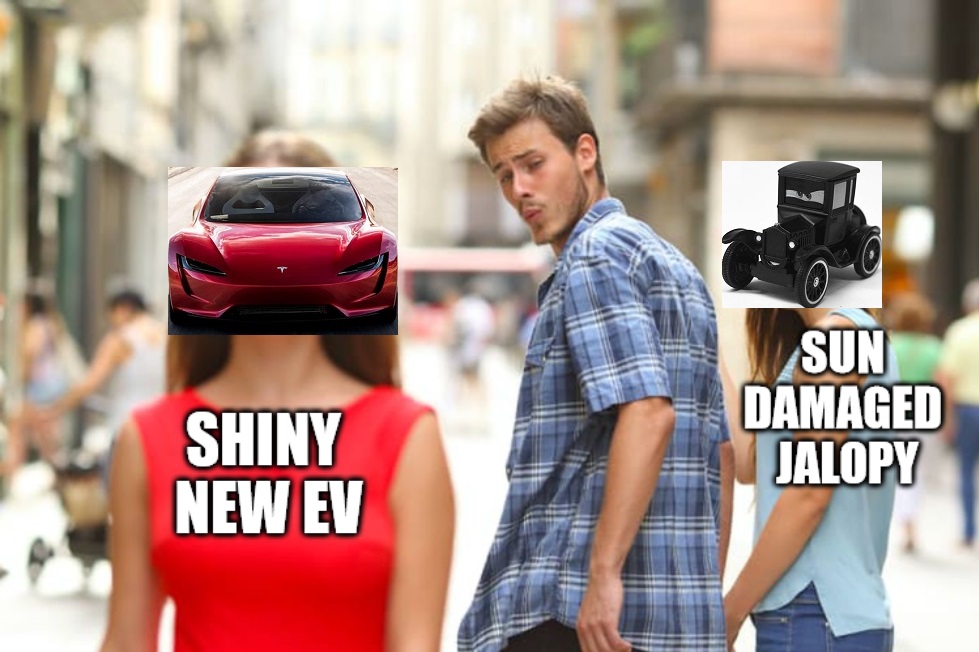
 RSS - Posts
RSS - Posts



Coincidentally I just watched a video about the Sonos and after learning about it and how high the amount of extra free km it provides in a week I don’t think I could justify buying an Ev without solar now.
For anyone who like me who doesn’t drive everyday it means almost never plugging in a car with any type of fuel again. Or being able to just top it up with a regular 3 pin plug without the the extra cost of a dedicated charger.
Also I think they can make solar cells look good on cars with custom shaped cells to match the contours of the car in the near future.
It is even possible to buy shock absorbers which generate a small amount of juice, so why not PV on the roof’s? As shown in the film “Who killed the electric car?”, California provided shaded parking lots with panels for charging.
Using your own solar generation to power your EV is about the only way to make them pay for themselves – fast charge stations charge near petrol prices per kilometre, and that’s without the taxes levied on petrol!
Like you, not driving every day means an EV could be driven one day, and recharged the next few days. The problem is that high cloud\rain low solar days mean low generation which translates to said EV not be recharged for 1-3 days unless grid power is used instead, which defeats the whole point of it. Sure if you know you’ll never drive 2 days in a row that may be safe, but if there’s a chance you might need to travel twice in a row …
I think your assumptions about how much power you can get out of the area on top of a car are optimistic. The Ioniq 5 you’ve pictured uses 23% efficient cells, so better than the 22% assumed, but the panel is only 205 W rather than 440 W.
There’s enough space on the roof of my 3 door Hyundai Getz for 104 Maxeon solar cells. That’s as many as in a 400 watt SunPower Maxeon panel and the Getz is small car. Of course, an EV manufacturer may not take full advantage of all the available roof space.
I think a big issue would be safely charging the EV battery (~300V?) from a PV system which probably has much lower voltage. Domestic PV installations have an inverter that converts the PV output to 240VAC. I understand the (domestic) Tesla Powerwall takes this 240V and charges its high voltage DC battery.
So no more sunroofs or roof racks, parking in garages or under carports. Just another thing to go wrong for so little benefit.
For many of us that’s not a problem. No need for a roof rack or sunroof and the car is parked in the sun 5 days a week while at work anyway.
Any real world numbers for the Ioniq 5 in Australia? Here in Norway 12-20 kWh total yield for June to December, from Norwegian Ioniq 5 user groups. 800 kWh in 20 years? Not worth the cost.
There are no Ioniq solar roofs in Australia, I’m afraid. Looking at solar output in Oslo the maximum amount of energy an Ioniq solar roof could generate from June to December might be around 95 kilowatt-hours if it was never shaded or snowed on. Given how the length of shadows and amount of snow in Norway and how much snow there is, only 12-20 kilowatt-hours might not be that bad.
Probably better off covering the vast areas of industrial shed-roof space with PV.
Also by distributing EV charge points among these vast solar rooftop – suburbs, workers could charge their EVs from that.
System wise, far more practical.
I wonder about wind generation? Surely driving at 40-60-80-100 kmh would provide a suitable amount of constant airflow to consider a designed for vehicle wind turbine or plural. We had radiator fans, why not wind turbines?
If it worked, wind turbines would be great because they would solve the perpetual motion problem! 🙂
I’m afraid any benefit from wind generation on a car world be more than cancelled out by the effects of increased air resistance. A stationary car could charge up its battery pack with a micro wind generator, but that would be less convenient, heavier, less reliable, and more expensive than PV.
Horses for courses. Far better to place PV on appropriate areas. In my case I have 12 volt/180 watts on my RV roof and a further 12 volt/180 watts on my tow vehicle roof. I never need mains power during my perambulations around Aus. and we watch tv, run two fridges, use radio and led lighting at appropriate times.
Not sure why the author left out Aptera since it’s also an ev that is in development with all of it’s beta vehicles having solar and claiming that they’ll get max 40 miles worth of solar a day. It’s claimed .13 drag coefficient and 3 wheel auto-cycle designation make it technically a motorcycle, but I think it’s disingenuous to leave them out because they’re ostensibly a car and not a motorcycle since you’d be in an enclosed roll cage and don’t need a helmet to operate it. It’s George- jetson-esque in it’s style, can only seat 2, so it’s not a market for everyone sure, but for a commuter it seems like a good enough market in the future if solar is going to get cheaper and in general more efficient vehicles that can utilize it by having ultra low drag coefficients, but if Elon can sell a low rez apocalypse mobile I think it stands to reason that standard assumptions about markets need to get re evaluated.
Definitely an interesting design. But there are no plans to sell any Aptera cars in Australia at the moment.
Hi Ronald,
I have one on order, with stated delivery time 2024-5 in west Australia
so its just waiting for my M3 when they first came out.
Good to hear! The delivery time is a long way off, but let me know how it turns out.
has any one tested windscreen shadeing solar panels on every window while parking or even driving on the side windows?
Do you believe the image you are using for this article is appropriate?
What IF it was a woman looking at a man, instead.
Respectfully.
I agree it would be better if the middle character was a women.
Any thoughts/information about hail damage to car-top solar?